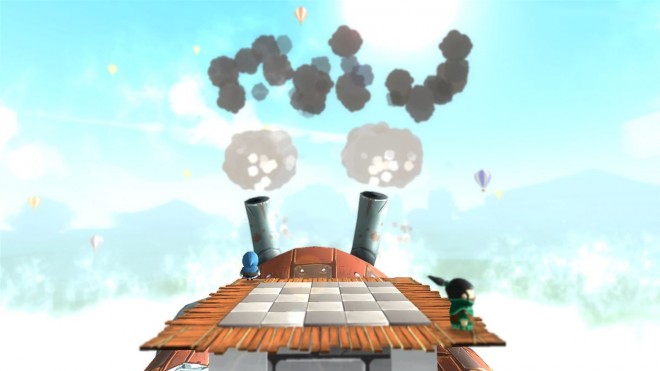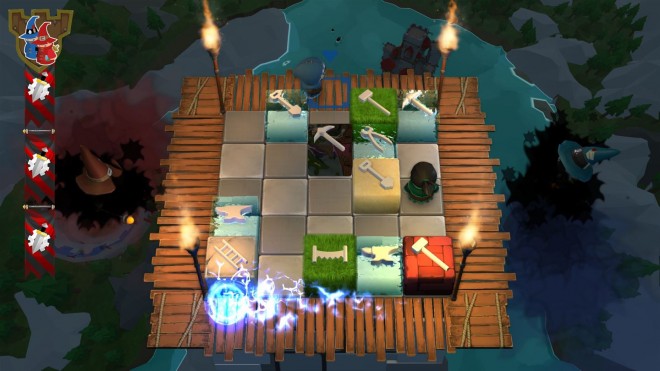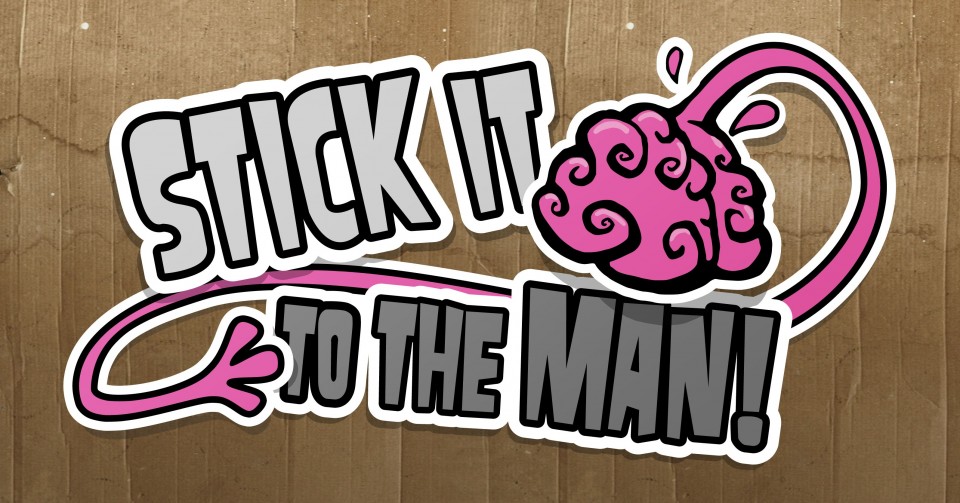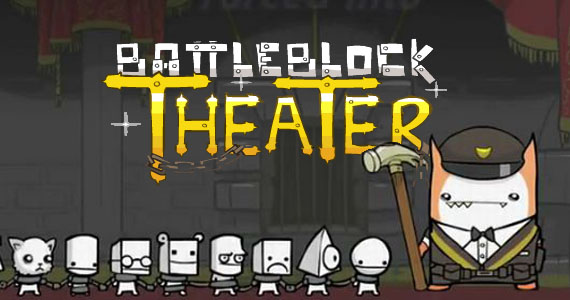If there is a more frustrating match three game than Castles in existence, then I haven’t found it. Nor do I want to. The game starts out well enough with a breezy, well made and colorful cut scene that introduces us to King Harold and his rival, King Edmund. Both of whom want nothing more than to build the tallest tower. The player is tasked with matching three blocks that either bear the same sign or are made from the same material in order to aid King Harold’s building efforts. Every ten levels, King Edmund sends a creature, a contraption or a minion to thwart King Harold, and the player is forced to endue a ridiculous spike in both difficulty level and blood pressure in order to progress.
In between these boss levels, Castles is a relatively easy-going match three that is built around the fairly unusual idea that players control a character on screen who must physically move blocks into place by pushing and pulling them. This adds a layer of complexity into the usual mix, because naturally, blocks can only be moved where the player can access them. Falling blocks that land on the player will also kill them, forcing them to respawn in a random square at the side of the board. There is a story mode with what the game description calls fifty levels (although it feels like five), a survival mode and a competitive multiplayer mode.
Here’s what I liked:
Bright and colourful – From the cut scene that introduces us to the King’s Harold and Edmund to the in game graphics, everything about Castles is chunky, bright and appealing with a genuine charm. Where it matters in the actual game, this graphical chunkiness is probably the best thing about Castles. The blocks scrape around the five by five grid with a pleasing weight, and the colour/material matching element is made easy by how identifiable each type of block is. The same can’t be said for the second kind of block matching that relies on the symbols printed on each block as once the board is crowded, it’s very hard to tell a shovel from a pick and a pick from a hammer, for example.
Cheap and cheerful – I’ve already covered how cheerful Castles looks, but when you take into account the fact that it costs less than five dollars, how bad could it be? And honestly, whatever else you read in this review, just bear the price of Castles in mind, because whilst I am about to throw a great deal of criticism at it, I did spend a good few hours fighting through the walls of frustration that it occasionally puts up. Competitive multiplayer, for example, is quite good fun because a frustration shared is a frustration halved, and the game verges on good fun between boss fights.
Here’s what I didn’t like
Beastly bosses – I hate the boss fights in Castles. The game pootles along for ten levels at a time, presenting next to no challenge except for the occasional issue of poor randomization among the blocks that fall, then suddenly, a boss fight. Bosses each have to be defeated in a specific way, which is a good thing for the sake of variety. In practice however, it is absolutely infuriating. The explanation about what to do is poor, and the issue of poorly randomized drops is compounded tenfold when a boss is adding complexities such as dead blocks and mass drops to the board. Most match three games are randomized, but the really good ones always feel as if they are at least possible. In Castles, it feels like it is entirely possible to have a game that is unwinnable through no fault of the player.
Oversensitive controls – Castles feature of controlling a character on the board who moves blocks around is fairly unique and has potential. It also creates a lot of frustration. Often, I found myself accidentally overshooting a square and messing up the entire board by shunting blocks that I didn’t mean to. This could have been fixed with an “undo” button or tighter controls, but alas, neither is present. There are other issues with the controls, for example the way that the game never gives the player the benefit of a “near miss” with falling blocks. It feels very much as if when you are in a square and the shadow above appears, you have next to no chance of moving, even when it seems like you have time to escape.
Repetitive – Whatever else it does or does not do well, Castles ultimately becomes as repetitive as it is frustrating. The developers have attempted to inject some variety into the game through the inclusion of very varied bosses, but as I’ve covered, I dreaded these due to how frustrated they made me feel. Outside of these boss fights, Castles is too easy, offering next to no challenge for ten levels at a time. New block types (both materials and symbols) are introduced, but rather than increasing the challenge level in a pleasing way, this just causes the random nature of the drops to become more annoying. Success in Castles is limited to simply having the right blocks fall and then shoving them into the right place, there is nothing more interesting to it than that.
Wrap-up:
You’ve probably gathered by now, I’m not the biggest fan of Castles, but that’s only really because it is incredibly frustrating and ultimately lacking in long term fun. It is well made and could have been really good, had the controls been better and some of the ideas been executed more cleanly. As it turns out though, it’s just a cheap and cheerful also-ran in a match three genre has plenty of much better options for players to choose from.
Score: Limited Appeal
Castles was developed and published by Badland Games on Xbox One. It releases on October 5 2016 for $4.99. A copy was provided for review purposes.






